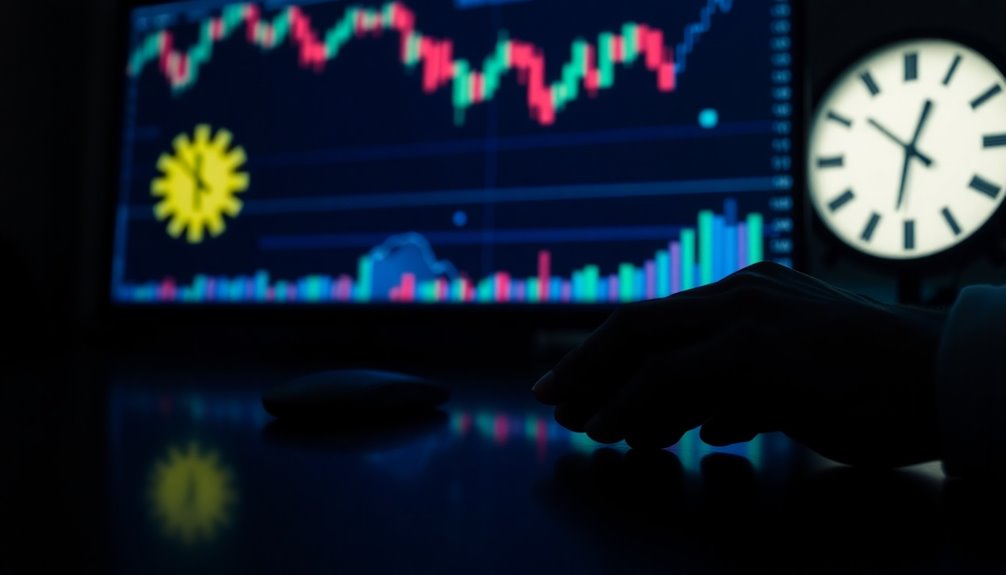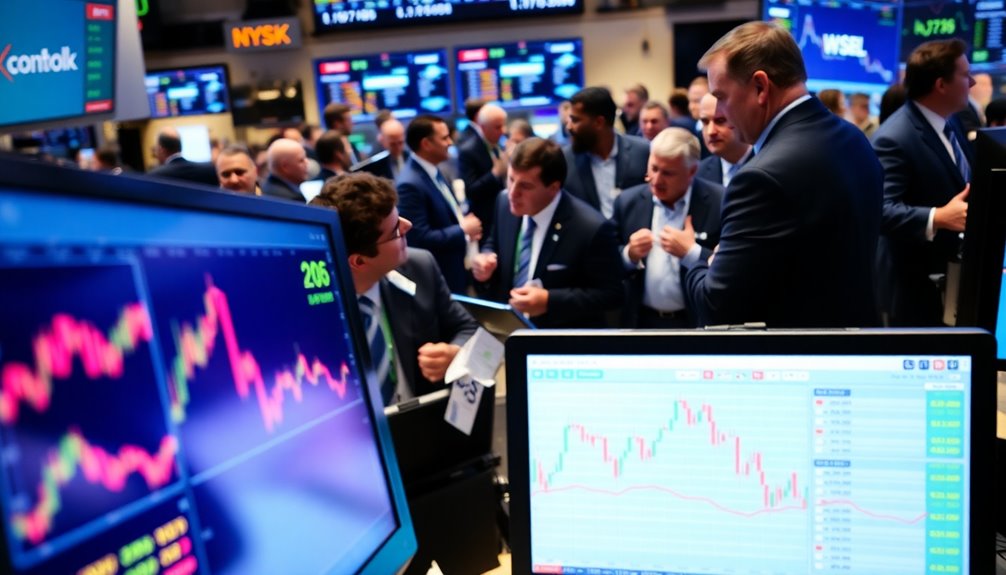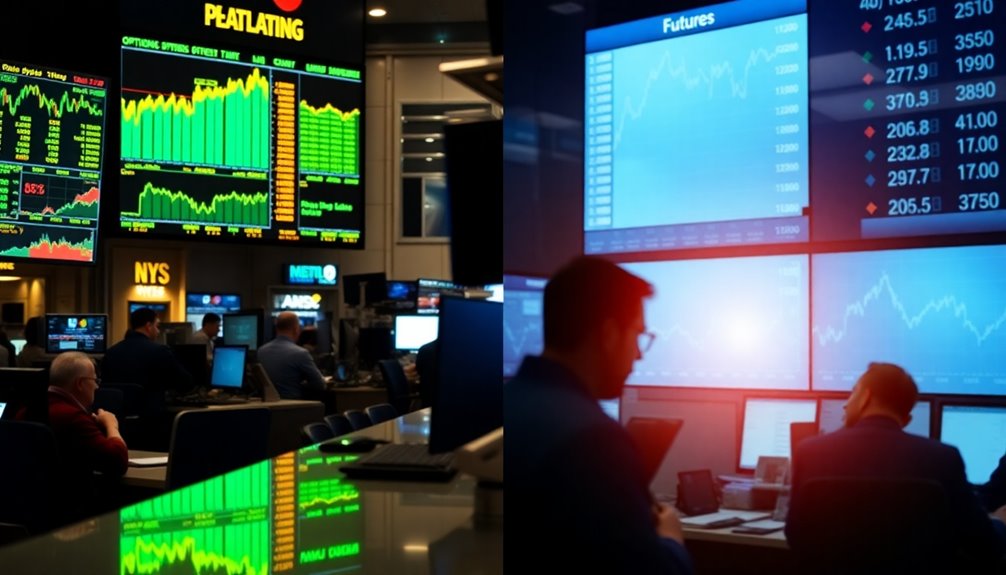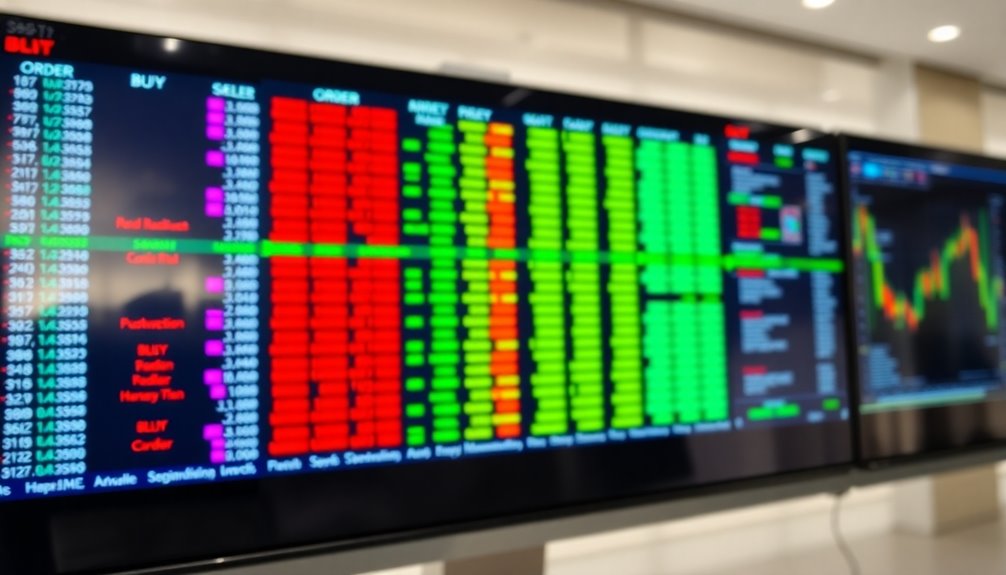Open interest indicates the total number of outstanding derivative contracts, like options or futures, that haven't been settled yet. It's a key measure of market activity and sentiment; rising open interest usually suggests increased market participation, while falling numbers may signal diminishing interest. High open interest often correlates with strong market conviction and liquidity, allowing for faster trade execution. When assessing potential price trends and reversals, it's handy to monitor open interest alongside trading volume. Understanding the nuances of open interest can significantly enhance your trading strategy and help you navigate market shifts effectively.
Key Takeaways
- Open interest reflects the total number of outstanding derivative contracts that remain unsettled or closed in the market.
- A rise in open interest indicates increasing market activity and trader engagement, suggesting stronger price trends.
- High open interest usually correlates with greater market liquidity, facilitating faster trade execution.
- Open interest can help identify market sentiment, with low levels signaling potential confidence issues in price movements.
- Analyzing open interest in conjunction with trading volume enhances understanding of market conditions and potential reversals or breakouts.
Open Interest Explained Simply

Open interest, simply put, is the total number of outstanding derivative contracts that haven't been settled or closed. It serves as a vital measure of market activity and participation.
When you see high open interest, it suggests that many contracts are still active, indicating that traders are engaged. If open interest is increasing, it typically means new participants are entering the market, anticipating significant price movements. This growth in open interest often reflects money flow into the market, signaling that traders are taking new positions.
Conversely, decreasing open interest hints at fewer active positions, which may signal a decline in market participation. Low open interest could mean minimal activity or that nearly all positions have been closed.
Understanding these dynamics helps you gauge the overall health and sentiment in the market.
Understanding Open Interest Basics

Understanding open interest goes beyond just knowing its definition; it's about grasping how this measure reflects market dynamics.
Open interest represents the total number of open derivative contracts that haven't been settled, including futures and options. You calculate it by adding all contracts from opened trades and subtracting the closed ones.
High open interest indicates active market participation and liquidity, allowing for quicker trade entries and exits. Conversely, low open interest suggests decreased market activity. Additionally, it can signal market sentiment; increasing open interest during price rises reflects a strong bullish trend, while decreasing open interest may indicate a weakening trend. High open interest often correlates with increased market activity, further validating the significance of this metric.
Analyzing open interest alongside other metrics enhances your understanding of market behavior.
Contract Creation and Termination

When a new buyer and seller enter a trade, they create a fresh contract that contributes to open interest. Each new contract you form, whether by taking a long or short position for the first time, adds to the overall open interest, reflecting new market participation. Open interest is a crucial metric for understanding market activity, as it indicates the total number of open contracts for a specific expiration.
There's no cap on the number of contracts that can be created in futures and options markets, so each contract you create increases open interest by one. Conversely, open interest decreases when both parties close their positions. This termination occurs when traders take offsetting positions or exercise options.
If you close more positions than you've opened, open interest drops. However, if you offset one position with a new one of the same size, open interest remains unchanged.
Pros and Cons Overview

After grasping how contracts contribute to open interest, it's important to weigh the advantages and disadvantages of this metric in trading.
On the plus side, open interest offers insights into market sentiment, liquidity, and trend strength, making it a valuable tool for your analysis. It's straightforward and can enhance your market awareness without complex charts. Additionally, increased open interest can indicate potential bullish market movements, further validating its usefulness.
However, keep in mind that open interest has limitations. It lacks predictive power and can be a neutral indicator without context. Extremely high open interest might signal overcrowded trades, increasing your risk.
Plus, it can lag behind actual market movements, making it crucial to use alongside other indicators for reliable insights.
Balancing these pros and cons will help you make informed trading decisions.
Options vs. Futures Open Interest

While both options and futures open interest serve as crucial indicators in trading, they each offer distinct insights into market dynamics.
Options open interest reflects the number of outstanding options contracts not yet closed, indicating liquidity and trading activity. A rise in options open interest usually suggests an influx of traders establishing positions, while high open interest in call options indicates bullish sentiment, and put options suggest bearish sentiment. In contrast, rising open interest in options often signals new money entering the market, suggesting trend continuation.
Futures open interest represents all open futures contracts, where each long position matches a short one. It informs you about capital flows, with rising values indicating money entering the market.
Market Volatility Concerns

Understanding open interest is key to grasping market volatility concerns. High open interest can indicate market confidence in ongoing trends, but it doesn't always predict price action.
When you see large open interest with high volume, it often suggests lower volatility, indicating deeper markets. However, unexpected volume shocks can boost volatility, while open interest usually mitigates these shocks. Changes in open interest can signal shifts in market sentiment, further highlighting the complexity of interpreting market conditions.
During volatile periods, increased speculation and hedging can occur, but these forces might balance each other out. In times of market stress, like during the 1997 Asian crisis, high volatility often leads to a drop in turnover and open interest.
Recent Open Interest Surges

As recent open interest surges signal shifting market dynamics, traders are keen to analyze how these changes reflect sentiment and potential trends.
High open interest often indicates strong market sentiment, confirming bullish or bearish trends. For instance, rising prices coupled with increasing open interest suggest new money entering the market, while falling prices with high open interest indicate a bearish outlook. Moreover, increasing open interest typically indicates robust market participation and sentiment, further validating the observed trends.
Surges can occur due to new buyers and sellers entering the market, enhancing liquidity and allowing for faster order fills. Notably, sudden spikes may reveal breakout opportunities, while low open interest during a market shift could hint at uncertainty.
Keeping an eye on these trends helps you refine your trading strategies and better navigate market conditions.
Monitor Volume Alongside Open Interest

Monitoring volume alongside open interest is crucial for traders looking to gauge market sentiment and validate price movements. High open interest indicates a significant number of active contracts, showing participants' continued interest, while high volume reflects strong trading activity.
When you see increasing open interest with rising prices, it often confirms a bullish trend. Conversely, high open interest with falling prices can signal a bearish trend. Additionally, open interest trends can provide insight into the number of participants interested in options, further enriching your analysis.
Low open interest paired with high volume may imply low liquidity, complicating trade executions. By combining these indicators, you can better assess market confidence and the strength of price trends, enhancing your trading decisions and strategies.
Always remember, understanding both open interest and volume is key to navigating the market effectively.
Frequently Asked Questions
How Is Open Interest Calculated in Financial Markets?
To calculate open interest, you start with the previous day's open interest, then add the number of new contracts opened during the day and subtract the contracts that have closed.
Remember, this applies to both options and futures. Each contract is only counted once, so there's no double counting.
This calculation updates daily, reflecting the current number of contracts that remain open in the market.
Can Open Interest Predict Future Price Movements?
They say, "What goes up must come down." Open interest can indeed help you predict future price movements.
When you see rising open interest alongside increasing prices, it often signals a strong bullish trend.
Conversely, if prices drop but open interest declines, that might indicate a bullish reversal.
What Role Does Open Interest Play in Liquidity?
Open interest plays a crucial role in liquidity by indicating the number of active contracts in the market.
When you see high open interest, it usually means there are more buyers and sellers, which enhances trading conditions. This greater participation often leads to tighter bid-ask spreads, making it easier for you to execute trades.
Conversely, low open interest can signal liquidity risks, making it harder to find buyers or sellers when you want to trade.
Are There Industry Standards for Open Interest Reporting?
Yes, there are industry standards for open interest reporting.
Clearing firms and omnibus accounts need to accurately report their open interest and large trader positions. You must submit daily reports by specific deadlines, using templates like the Large Trader Reporting (LGTR).
Additionally, calculations consider settlements and position transfers before the cut-off time, so timely reporting is essential to maintain transparency and ensure compliance with regulatory requirements in the market.
How Often Should I Check Open Interest Data?
You should check open interest data as if your trading strategy depends on it—because it does!
Daily updates give you a solid snapshot, but if you're an intraday trader, you'll want real-time insights to catch those market waves.
During significant events, keep a close eye to gauge reactions.
And remember, combining it with volume data can unlock powerful insights.
Stay proactive, and your trading game will soar!
Conclusion
In conclusion, understanding open interest is crucial for navigating the trading landscape. It helps you gauge market sentiment and potential price movements, giving you an edge in your decisions. By monitoring open interest alongside volume, you can spot trends and make more informed choices. So, why not dive deeper into this essential indicator and see how it can enhance your trading strategy? After all, knowledge is power when it comes to the ever-changing market!









